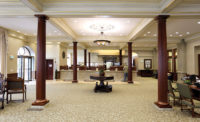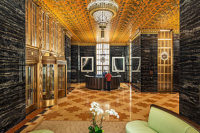Freemasons’ Hall in London, England, first opened in 1933 as a memorial to the 3,255 freemasons who died during active service in World War I, and has since been used for events, as well as the meeting place for the Grand Lodge and other annual meetings of the home counties. Recently, Mapei adhesive and grout products were chosen for the installation of a stone pattern in the reception and washroom areas in a refurbishment project of the hall.
“As a Grade II listed building, only heritage approved materials and designs, which have to be in keeping with the original building and fabric, may be used both inside and outside of Freemasons’ Hall,” explained Mark Kennedy, head of building maintenance at the hall.
Avantgarde Tiling of London, England, was contracted to design, supply and install a new stone pattern for the reception floor area, as well as to install large-format porcelain tiles and feature walls, including a stone vanity and credenza tops, to the washroom area.
The project was completed using Mapei products, including the popular Ultracolor Plus grout in Limestone (shade reference 299), which was applied to 70 square meters of tiling within the reception area of the building. White Kerapoxy was applied to 94 square meters of washroom tiles, ensuring that a stain-resistant approach was installed in areas subject to heavy foot traffic.
The building is considered to be one of the finest art deco buildings in England, and as such was in constant use throughout the renovation. The reception area was completed over two weekends of work, first requiring a quick setting screed for the installation of substrate. Mapei’s Ultraplan Renovation screed 3240 was specified for its quick setting properties, allowing Avantgarde Tiling to install a temporary carpet over the substrate so that the venue could be used without any constraints. The following weekend, the installation of the new stone floor was carried out entirely using Mapei’s Ecoprim T, Adesilex P10 for mosaics, Elastorapid Grey A for fast track floors and Keraflex Grey Maxi for the large-format wall tiles. These products were ultimately chosen for their suitability to the listed interior of the building.
Upon completion, all involved were pleased with the outcome. “Everyone who sees the project pictures comments on how good it looks -- a positive reaction,” said Kennedy.






